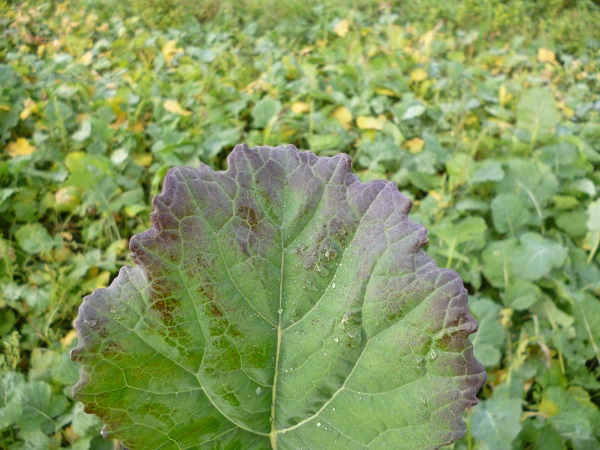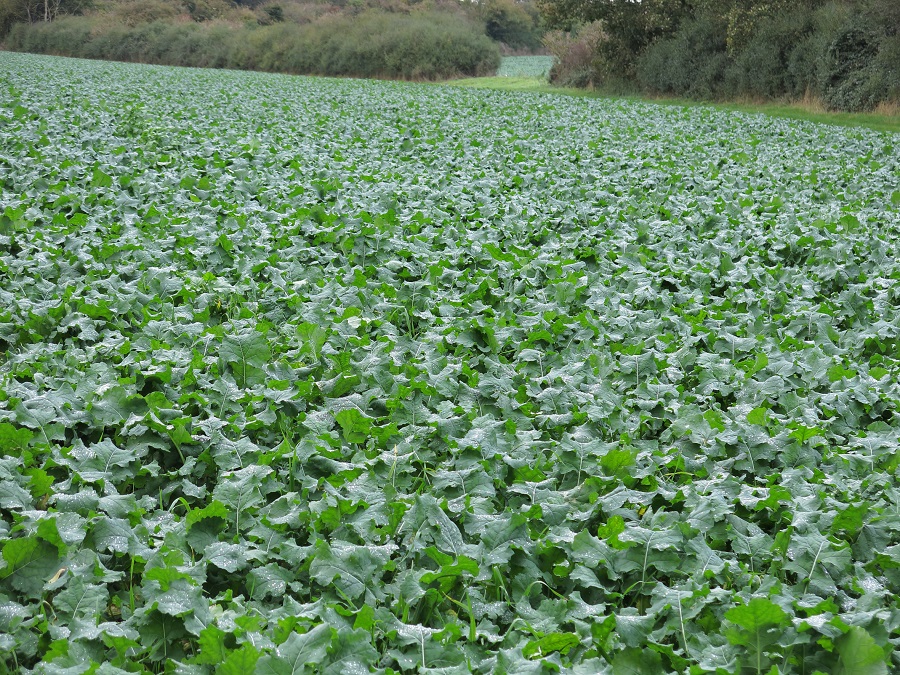The loss of neonicotinoids has added insult to injury for growers struggling with TuYV pressures, meaning varieties with “built-in” resistance are more important than ever. CPM tracks the journey of one breeding programme, from lab to field.
More than 10 years ago, our breeders estimated that the TuYV could become a major threat to OSR.
By Charlotte Cunningham
Turnip Yellows Virus – carried by the peach-potato aphid (Myzus persicae) – has long been the arch nemesis of oilseed rape, causing potential crop losses of up to 30% in the worst-case scenario.
Until recently, neonicotinoid seed dressings provided fairly good control of aphids, keeping the yield-robbing virus at bay. But following the loss of the crop protection product, growers have been left with a limited number of options.
However, several OSR breeders had the foresight to start researching whether varietal control was possible long before the loss of neonics made the genetic route necessary, meaning growers now have a range of TuYV-resistant varieties at their disposal.

Turnip Yellows Virus – carried by the peach-potato aphid causes potential crop losses of up to 30% in the worst-case scenario.
One of the early developers of “built-in” TuYV resistance was DSV, with a TuYV breeding programme starting in Germany at the beginning of the century in response to some major challenges faced by growers in the country.
“More than 20 years ago, our breeders estimated that the TuYV could become a major threat to OSR growers as a result of climate change, a shift in agricultural practice and stronger pesticide regulations,” explains Simon Kroeger, OSR product placement manager at DSV in Germany. “Therefore, joint research projects were established in order to ensure that resistance was developed for OSR breeding programmes.
“Luckily, their guess was right, and we now have a new generation of hybrids that are prepared for the increasing TuYV presence.”
The initial research project began in 1994 and breeders quickly established that TuYV was defined as an independent virus strain and that resistance could be integrated within breeding material, explains Simon. “Genetic markers were developed so that the new breeding material could be screened with PCR analysis for the incorporation of the TuYV resistance in our breeding material – including the mother and/or father lines.
In terms of developing the resistance itself, DSV optimised a resistant source created from a resynthesis of cabbage (Brassica oleracea) and turnip (Brassica rapa) developed by researchers at the University of Göttingen, he adds. “This line was called R54 and carried the TuYV-resistant gene, so for our breeders, the first step in the DSV breeding programme was to include this R54 line and start breeding for new lines that included said gene.”
Together with the University of Göttingen, R54 was crossed with a DSV breeding line and the first output was a new DSV father line carrying virus resistance.
While this resynthesis proved to be a pivotal part of the development programme, it came with challenges, adds Simon. “The problem with these resyntheses is that they bring a lot of negative characteristics like low yield and low oil content – as well as high glucosinolate and erucic acid content – so it does take some time to incorporate the new resistant gene into a hybrid that is also competitive on the market.
“We saw such problems in clubroot resistance breeding too, but finally we managed to breed hybrids without any yield depressions and with the critical TuYV resistance.
“In fact, we’ve managed to swing it the opposite way and the new TuYV resistant hybrids often perform better than non-resistant types – regardless of whether or not you have TuYV in your field.”
In the early stages of the project DSV teamed with other breeders, universities and state research institutions in order to assist the development process. “The basic research on resistance is often carried out in this way, using private-public partnerships and state-funded research projects between many partners.
“For medium-sized breeders like DSV fundamental research is very costly and can be only carried out together with a number of partners, so that knowledge from a range of experts helps to find new solutions.”
While TuYV-resistant varieties are now available for growers to utilise, how is the overall virus picture looking? “Aphids often thrive on buffer strips and cover crops and as they’ve increased, the aphid population has also grown, adds Simon. “On top of this, the loss and declining efficacy of seed treatments have led to higher levels of damage to plants, and the warm winters we’ve experienced in recent years have helped the aphids survive for longer and make more generations – so overall, this has led to higher infection rates.”
In the UK, a series of tests carried out at the University of Warwick and NIAB in 2019 suggested over 90% of UK oilseed rape carried TuYV, says DSV UK’s Sarah Hawthorne.
“We looked at crops across a range of locations from North Yorks down to Wilts and from Shrops across to Lincs.
“All samples were taken randomly from crops that looked to be healthy and growing strongly and out of the 60 samples taken, 55 of these were found to be positive for TuYV – which represents a 91.7% level of infection.
“While we probably haven’t seen the devastating yield losses experienced in other parts of Europe yet, TuYV is a growing issue in the UK and probably responsible for taking the edge off yields in more crops than people realise.
According to Sarah, it’s a situation that can only get worse as the populations of Myzus persicae responsible for carrying the virus get harder to control. “People have got to take it seriously.”
While TuYV-resistant varieties are the only practical means of curbing the problems caused by the virus, they also bring with them additional benefits relevant to modern production challenges, she says. “Certainly, with our own TuYV varieties, we’ve noticed that they are much more tolerant to abiotic stresses such as drought and poor growing conditions, than other varieties.
“There’s growing evidence that the inclusion of TuYV resistance is also connected with high levels of vigour, too.
“Most oilseed rape varieties will stop growing when temperatures fall to 5 – 7oC but TuYV varieties seem to keep growing until much colder conditions prevail. It’s very noticeable when you compare TuYV-resistant varieties against others in the field in late autumn.
“It’s also possible that TuYV varieties may handle higher nutrient applications more efficiently with fewer canopy problems resulting.”
While for now, DSV seems to have produced a solution for a key OSR challenge, what does the future hold for breeding and TuYV resistance? “For DSV, TuYV resistance will be a key trait and we expect that in the coming years over 90% of our new varieties will carry the resistant gene,” explains Simon. “We also plan to stack more traits together in one hybrid. Over the next year we will launch our first TuYV-resistant Clearfield hybrid, and the first TuYV-resistant clubroot hybrid.
“Both of these hybrids also carry phoma and pod shatter resistance so effectively we will have varieties in our portfolio that have four different resistances in one hybrid.”
According to Simon, observations have shown that TuYV-resistant hybrids have a better autumn vigour and a better N-efficiency, which is another area their breeding will target over the coming years. “As the challenges for farmers never stop, we always have a lot of work to do as breeders to be able to support farmers with varieties that can be grown more efficiently, with less input, and more resistance against important OSR diseases like phoma, LLS or verticillium wilt.
“And of course, solutions for the cabbage stem flea beetle need to be found very soon.”
A tempting choice?
DSV’s first TuYV-resistant variety to join the AHDB Recommended List was Temptation in 2019/20 and it currently sits on the 2020/21 list as suitable for the whole of the UK with a yield of 103% of control and an oil content of 46.0%
The variety’s combination of high yields in challenging conditions and strong all-round disease package make it one of the most reliable ‘drill and forget’ oilseed rape choices currently available, says Sarah. “By any standards Temptation is one of the highest performing varieties currently available in the UK.”
Darling and Dazzler also joined the 2020/21 AHDB RL as DSV’s first ever triple-layered varieties combining high gross outputs with TuYV, RLM7+ phoma stem canker and pod shatter resistances.
“Both Darling and Dazzler have been developed in response to the demands faced by growers, in particular the need for lower cost management and to address the impact of reduced agrochemical availability in the future.
“They are designed to deliver sustained early vigour in the field to grow through pest and disease attack while exhibiting a range of features that support them from canopy development through to harvest.”
Both varieties score 8 for phoma stem canker and 6 for light leaf spot resistances with one of the main features shown in AHDB trials being their consistency of yield production, she says.
“Darling has a gross output of 103% and Dazzler 104% with gross outputs consistently at or over 100% of control over the past three very different growing years.
“This underlines their production stability and resilience, and this is of real significance in the challenging and more variable climatic conditions widely predicted in the years ahead.
“Oil content is also impressive at 46.0% for Darling and 46.2% for Dazzler with the varieties’ TuYV resistance being a key feature for future protection of margins.”
All three varieties will be joined by other TuYV-resistant varieties in the years ahead and the trait will be a key element of DSV varieties moving forward, Sarah Hawthorne says.
“UK growers can expect a high yielding DSV Clearfield variety with TuYV resistance very soon and there are other TuYV-resistant varieties now moving through the UK testing system. We don’t see the issue becoming any less of a problem in the future.”
What does the science say?
Dr Steve Foster of Rothamstead Research has been keeping a watchful eye on insecticide resistance levels in aphids and says the outlook is fairly grim without key control options – like neonicotinoids – meaning varietal resistance is imperative for growers.
“We’re keeping an eye on the building resistance levels, and in the UK there’s no known resistance for neonicotinoids. Losing them has been a really unfortunate loss for the industry as they were great for preventing virus transmission.”
With the peach-potato aphid (Myzus persicae) being one of the biggest hosts of the virus, and the loss neonicotinoids arguably causing an increase of numbers, there’s limited options for growers, he adds. “In testing carried out a few years ago, we looked at the presence of M. persicae in suction traps and found very high levels of TuYV.
“I think that the loss of neonics since then will only mean that the virus levels increase – slightly worrying when at our York site over 80% already carried TuYV.”
As a result, some growers have been turning to pyrethroids as an alternative. However, this could worsen the problem, adds Steve. “The most important thing is stopping the transmission, however, M. persicae already have a high degree of resistance to pyrethroids.”
What’s more, pyrethroids could have an adverse effect on beneficial insects, which could cause further issues for growers. “Beneficial insects like parasitic wasps risk being killed by pyrethroids, but they’re an important component of an IPM strategy that’s recommended for optimum TuYV control.”
According to Steve, the way forward now is to optimise varieties that have resistance in them. “As well as this, ensure you’re looking at surveys and reports to keep on top of exactly when aphids are coming into crops.
“Monitoring will become more and more important, as will deciding when to – or not to – spray.”
Innovation Insight
CPM would like to thank DSV for kindly sponsoring this article, and for providing privileged access to staff and material used to help put the article together.




